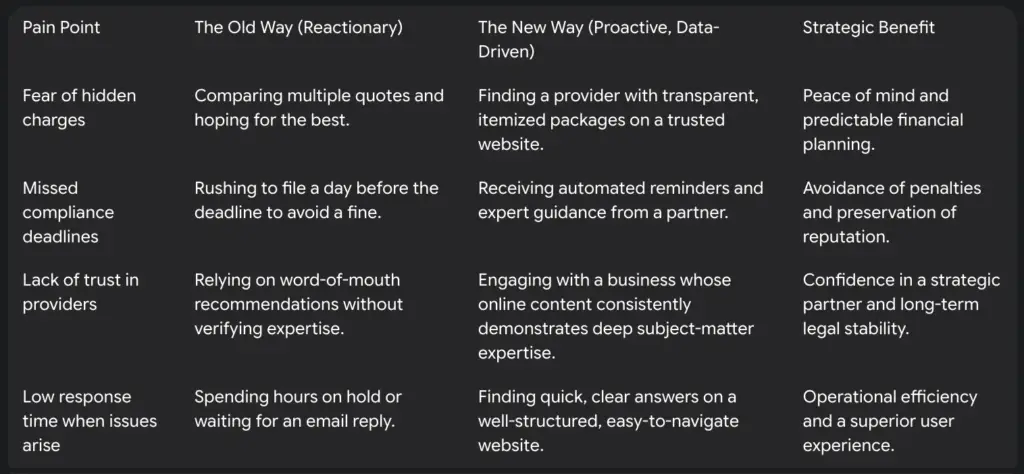In Singapore’s competitive professional services landscape, SME owners face a significant trust deficit rooted in concerns over hidden charges, legal non-compliance, and slow response times. The key to achieving a high return on investment (ROI) from Google is to build a digital presence that directly addresses these pain points by demonstrating transparency and expertise
The Trust Deficit: Unpacking the Singapore SME's Digital Marketing Pain Points
The journey of a Singaporean SME owner is often defined by a series of complex and high-stakes decisions, particularly when it comes to business fundamentals like company incorporation and regulatory compliance. These critical tasks are frequently accompanied by significant frustration. The market is perceived as one of costly mistakes, hidden charges, and slow response times, creating a profound trust deficit between service providers and their clients. For many, a bad experience with a single provider—such as encountering an unexpected fee or a delayed response—instills a deep-seated suspicion of the entire industry. This is more than a service problem; it is a fundamental breakdown of trust that digital marketing must address.
The pain points experienced by SME owners are tangible and have real-world consequences. During the company incorporation process, common pitfalls include choosing an inappropriate business structure, neglecting to draft a comprehensive founders’ or shareholders’ agreement, or providing incorrect information on registration forms. An inadequate understanding of compliance requirements can result in severe financial penalties, legal repercussions, or even business closure. Similarly, corporate secretarial duties, which are mandatory for all Singaporean companies, are fraught with risk. Mistakes such as missing statutory filing deadlines or improperly managing corporate records can lead to escalating fines, with penalties starting at SGD 300 and potentially reaching up to SGD 10,000 for directors who consistently fail to comply. These missteps not only result in financial burdens but also damage investor confidence and raise red flags during audits or due diligence checks.
A major source of frustration is the lack of pricing transparency. Many SME owners attempt a do-it-yourself approach to compliance to save money, only to find themselves grappling with complex issues later on, such as poorly drafted agreements or improperly submitted minutes. The fear of hidden charges is a direct result of this opaque market, where providers offer seemingly low-cost packages that do not account for a myriad of potential add-on fees. These extra charges can cover everything from XBRL filing and the provision of a nominee director to ad-hoc drafting of resolutions or CorpPass management. This combination of high-risk tasks and an untrustworthy market environment creates a situation where the primary challenge is not merely to sell a service but to first build a strategic relationship based on absolute transparency and demonstrable expertise. Digital marketing must be framed as a solution that alleviates these fears and establishes a new standard of partnership.
This table connects the common business pain points faced by SME owners to the strategic solutions that a modern, data-driven online presence can provide.

The Credibility Engine: Building Trust and Authority with White-Hat SEO
The foundational strategy for overcoming the market’s trust deficit is to build an online presence rooted in white-hat SEO. Unlike black-hat SEO, which uses manipulative tactics for short-term gains, white-hat practices prioritize the user experience and long-term viability of the website. This approach is not a quick fix; it is a sustainable, Google-friendly methodology that avoids the risk of severe penalties or permanent bans. A business that embraces this methodology is signaling its commitment to integrity and quality, which directly contrasts with the audience’s perception of a market filled with deceptive and opaque practices.
At the heart of a successful white-hat SEO strategy for professional services is content marketing. In the B2B sector, content is not merely a promotional tool; it functions as a digital consultant, providing educational and insightful information that addresses a prospective client’s most pressing concerns. By crafting content with a “journalism pedigree,” a company can bring clarity to complex topics, illuminating its message for greater impact and building trust. Instead of a sales pitch, a website’s content can be a roadmap for the SME owner, guiding them through common pitfalls and compliance requirements. For example, a blog post titled “9 Common Mistakes to Avoid During Company Incorporation in Singapore” or “Common Compliance Mistakes that Corporate Secretarial Services Can Help Prevent” serves as a public service announcement that establishes the company as a knowledgeable and trustworthy expert.
Beyond content, a strategic link-building program reinforces this foundation of credibility. In simple terms, a high-quality backlink is a “digital referral” or a “popularity vote” from a reputable third-party website. This is a process of earning trust, not buying it. An organic, outreach-driven approach, such as pitching custom content or guest articles to industry-relevant publications, builds brand authority and trustworthiness in the eyes of search engines. The strategic value of this approach extends far beyond SEO. When a professional services firm earns links from respected sources, it is implicitly demonstrating its commitment to transparency and excellence. The very act of appearing high in search rankings for complex, high-stakes topics demonstrates that the business has earned the digital “votes of confidence” from the broader internet ecosystem. This directly counters the SME owner’s deep-seated fear of engaging with an unproven or unreliable provider.
The Conversion Funnel: Targeting High-Intent Leads with Paid Media
While a strong SEO presence is essential for building long-term credibility, a B2B professional services firm must also actively and efficiently capture leads that are ready to take action. This is where a precision-targeted paid media strategy comes into play. The fundamental difference between B2B and B2C paid campaigns lies in their objective; B2C campaigns often seek broad reach for quick transactions, whereas B2B campaigns must focus on connecting with decision-makers at the right stage of a longer sales cycle. The goal is to drive conversions and high ROI by targeting a niche audience with a precise message that speaks directly to their needs.
This strategic approach begins with an advanced keyword strategy. Rather than targeting broad, general keywords, it is crucial to focus on long-tail, high-intent keywords that signal a readiness to engage with a professional service. These search queries often include words like “incorporation cost,” “corporate secretarial fees,” “hire,” or “price”. By targeting these terms, a business can attract prospects who are actively seeking a solution and are further down the sales funnel, leading to higher conversion rates and a more efficient allocation of marketing spend.
A sophisticated B2B paid media strategy also leverages Account-Based Marketing (ABM). This approach shifts the focus from a broad audience to a curated list of high-value, target accounts. By creating tailored ads that address the specific challenges of a particular company or industry, ABM helps to drive better engagement and a higher return on ad spend. The ad copy itself must be meticulously crafted to resonate with this audience. Instead of generic descriptions, the copy should emphasize how the service solves specific problems or delivers tangible outcomes, such as “helps save 10 hours a week on compliance filings” or “ensures long-term legal and financial stability.” Strong calls-to-action (CTAs) are essential, with options like “Download Our Whitepaper” or “Get a Free Consultation” enticing prospects to take the next step.
Paid advertising can be implemented on a number of platforms, with Google Ads being the most obvious choice for its ability to place a business in front of users actively searching for services. The use of Microsoft Ads, which has a strategic advantage for B2B due to its integration with professional platforms like LinkedIn, allows for highly granular targeting based on job titles, industries, and company names. This allows a business to match its ad content to the professional interests and duties of its target audience, improving both engagement and conversion rates. By focusing on precision targeting and high-intent keywords, a B2B firm can bypass low-quality traffic and directly capture leads that are prepared to convert. This is how paid media becomes a highly efficient engine for generating B2B leads.
The Next Frontier: Dominating with Google's SGE and AI
For professional services firms, the future of digital marketing is already here with the rise of Google’s Search Generative Experience (SGE). SGE represents a fundamental shift in the search paradigm, moving away from a traditional list of “10 blue links” to providing direct, AI-generated summaries that synthesize information from multiple high-quality sources. This innovation is a response to complex, conversational, and multi-faceted queries, and its adoption necessitates a recalibration of existing SEO strategies. It is now more important than ever for a professional services firm to prove its expertise, as SGE’s AI models are designed to elevate content from the most authoritative and trustworthy sources.
In this new era, the SEO principle of E-E-A-T (Experience, Expertise, Authoritativeness, and Trustworthiness) becomes the core prerequisite for visibility. SGE’s AI systems are engineered to differentiate between credible, trustworthy content and thin, unverified information. A business must now actively showcase its professional credentials, publish content under named contributors with verifiable author bios, and provide unique, data-driven insights to be considered an authoritative source. The long-term credibility built through white-hat SEO is no longer just a best practice; it is a core requirement for a business’s discoverability. The very act of appearing in an SGE summary signals a level of trust that directly alleviates the SME owner’s fear of engaging with an unproven provider.
A key strategic shift to adapt to SGE is the adoption of the Topic Cluster Model. Instead of creating isolated pages for individual keywords, a business should build a comprehensive, interconnected content library around core subject areas. This involves creating a detailed “pillar page” that broadly covers a topic like “Company Incorporation” and linking it to multiple “cluster pages” that provide in-depth information on sub-topics such as “Choosing a Business Structure” or “Legal Requirements for Shareholders’ Agreements”. This structure makes the entire website an authoritative resource for SGE’s AI, increasing the likelihood that it will be cited in an AI-generated summary and driving traffic to deeper pages on the site.
Technical excellence also plays a critical role in the AI-first search landscape. SGE relies heavily on structured data and schema markup to understand the context and intent of content. Implementing relevant schema types such as FAQ, HowTo, or QAPage can help SGE’s AI systems better parse and present information in its summaries. Content itself should be written in a natural, conversational style with clear headings and bullet points to make it easily digestible for both human readers and AI models. This approach transforms SEO from a simple marketing tactic into a fundamental business imperative, where a firm’s commitment to proving its expertise is a prerequisite for achieving visibility and trust in the digital realm.
The Strategic Loop: Analyzing ROI and Optimizing for Growth
The most effective digital marketing strategy is a continuous, data-driven feedback loop. Moving beyond vanity metrics like page views and bounce rates is crucial. For professional services firms, success is measured by key performance indicators (KPIs) that are directly tied to business outcomes. These include financial metrics such as annual revenue per billable team member, which indicates overall profitability and efficiency, and profitability metrics like gross margin and realization rate, which show how well a business monetizes its services and manages project scope. By tracking these metrics, a firm can bridge the gap between its digital marketing efforts and its organizational strategy, ensuring resources are allocated to the most effective channels.
A deep understanding of user behavior is also vital for optimizing a website for maximum return. Tools like heatmaps and session recordings provide a qualitative lens on user interaction, showing where visitors click, where they scroll, and where they get confused. This data is invaluable for identifying digital “friction points” on a website, such as a form that is too long, a confusing navigation menu, or an unresponsive button that leads to “rage clicks”. These digital bottlenecks are the online equivalent of a slow response time or a bad in-person experience; they erode trust and discourage conversion.
The process of analyzing this data and implementing changes is what truly sets a strategic partner apart. By using insights from heatmaps and session recordings, a firm can form data-backed hypotheses for A/B testing and continuously refine the user experience. For example, if session recordings reveal that users are struggling to fill out a contact form, A/B testing can be used to compare a new, simplified form against the old one. The ultimate goal is to create a seamless, intuitive, and high-converting website experience that signals professionalism and competence before a single conversation is had. This data-driven approach is the ultimate answer to the user’s pain point of “low in response time,” as it provides a proactive way to build trust and demonstrate a commitment to excellence.
Your Next Step: A Guide to Hiring the Right Specialist
The digital landscape for B2B professional services is changing rapidly, but the core objective remains constant: to build and maintain trust with a discerning audience. The SME owner’s fear of hidden charges, compliance mistakes, and slow service is a direct signal that the market is ripe for a new approach—one that is transparent, proactive, and rooted in expertise. The strategic blueprint outlined here provides a holistic solution that addresses these pain points head-on.
By committing to a white-hat SEO strategy, a firm can build a foundation of credibility that ensures long-term visibility and counters the industry’s trust deficit. By leveraging precision-targeted paid media, it can efficiently capture high-intent leads that are ready to engage. Furthermore, by anticipating the shift to Google’s Search Generative Experience, a business can future-proof its online presence by proving its expertise to both human and AI audiences. Finally, by embracing a data-driven approach to optimization and offering a high-value lead magnet, a firm can demonstrate its commitment to a superior, frictionless client experience. This is not merely a marketing plan; it is a blueprint for enduring growth, turning costly headaches into a strategic, profitable digital presence.




